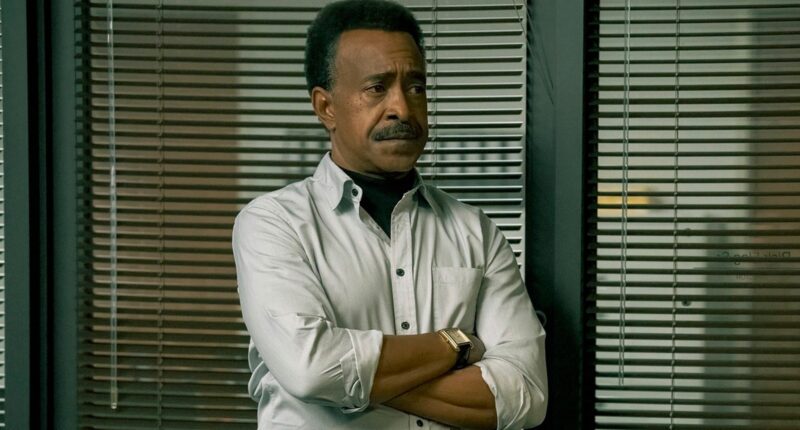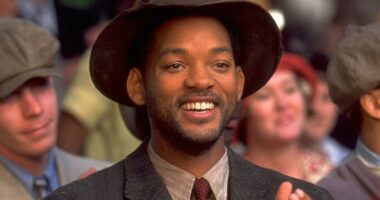Share this @internewscast.com
Contains spoilers for “Peacemaker” Season 2
Christopher Smith, better known as Peacemaker, portrayed by John Cena, returns for a second season in “Peacemaker.” Initially introduced as a villain in “The Suicide Squad,” the first season of his solo show delved into his complex past, revealing a deeply scarred individual burdened with trauma. In this new season, Peacemaker still contends with the disdain of the world, specifically from the powerful group A.R.G.U.S., while navigating his relationships with friends like Emilia Harcourt, played by Jennifer Holland. Overwhelmed, he discovers an escape: a portal to another dimension right inside his house, offering a potential way out of his troubles.
The core storyline for “Peacemaker” Season 2 revolves around Chris’s dilemma: does he face his difficult reality or immerse himself in a replacement universe? The season incorporates many signature elements of James Gunn’s comic book storytelling, with Gunn returning as the showrunner. Although fans familiar with Gunn’s work will likely enjoy it, the season presents some artistic challenges. An analysis of “Peacemaker” Season 2 indicates it lacks the cohesion of the debut season, which set a high standard. Let’s break down the successes and missteps of this new installment.
Worked: John Cena’s nuanced performance
From his comedic roles in films like “Trainwreck,” “Sisters,” and “Blockers” throughout the 2010s, John Cena has consistently surpassed expectations with his acting range beyond his wrestling roots. It is as a superhero that Cena truly finds his acting stride. In “Peacemaker” Season 2, his character shifts from someone who would do anything for the sake of “freedom,” regardless of the collateral damage, to a man seeking redemption. In his quest for personal growth, he often finds solace in another reality where his long-held emotional wounds are healed.
In this season, Cena deftly portrays the more troubled and exasperated dimensions of Peacemaker. The depiction of his pain is compelling, making it easy for viewers to connect with someone who was once so detestable in “The Suicide Squad.” Despite maintaining his physical prowess and comedic flair, Cena adeptly handles the heavier emotional content of “Peacemaker” Season 2. There are genuinely heartfelt moments, notably those centered around Peacemaker’s longing for familial love and acceptance.
Didn’t Work: Stale multiverse visuals
Once again, a James Gunn-directed DC Comics project encounters visual issues in 2025. The film “Superman” experienced some dissatisfaction with its visuals, and similar problems appear in “Peacemaker” Season 2, potentially more pronounced due to what seems to be a reduced budget and a plot involving multiple dimensions. Though the narrative begs for varied visual storytelling through distinct lenses, color schemes, and camera angles to differentiate realities, the show’s portrayal of the utopian realm appears visually similar to the one Peacemaker initially inhabits.
Gunn misses opportunities to utilize the creative potential of a multiverse-rich narrative. While movies like the “Spider-Verse” series and “Everything Everywhere All at Once” creatively embrace diverse visuals to enhance their storytelling, “Peacemaker” Season 2 suffers from a lack of visual dynamism. “Superman” offered vibrant colors and thrilling action to offset its conventional cinematography. However, the more focused narrative of “Peacemaker” Season 2 highlights the missed chances to visually distinguish its multiversal elements.
Worked: Messy relationships
James Gunn’s “Guardians of the Galaxy Vol. 2” script is rife with brilliant decisions, but one especially inspired choice was leaning into how these cosmic outcasts didn’t necessarily love each other now that they were working together. They were a team, but not a surrogate family — at least, not yet. That transitional period for unexpected allies endures in “Peacemaker” Season 2. Peacemaker, Harcourt, Leota Adebayo, Adrian Chase/Vigilante, and John Economos are kind of buds now, but not without immense difficulties. Economos is constantly aloof with everybody, Adebayo remains in denial about how rough her life has gotten, and Harcourt and Peacemaker have differing ideas of where their dynamic should go next.
There are jagged imperfections with these people, even though they’ve now found friendship. Saving the world from “Project Butterfly” in Season 1 only opened up the door to new problems in their messy lives rather than solving all their issues. The best bits of drama in “Peacemaker” Season 2 come from the complex relationships between these souls. Harcourt, for instance, has no patience for Peacemaker or Chase, yet Gunn consistently shows her being close with Adebayo. Economos, meanwhile, gradually develops some older sibling energy with the needy Chase while remaining as frustrated with Peacemaker as he is worried about him. Committing to these nuanced dynamics results in a messier but more compelling rapport between the central players.
Didn’t Work: Weird pacing
The fifth episode of “Peacemaker” Season 2 changes the status quo for the entire show, with Peacemaker opting to live permanently in the alternate dimension with his brother and dad. It’s also a moment that feels like it should have come way earlier in the season. Before that, the episodes are weirdly interchangeable. Making this season as one story stretched across eight episodes robs individual installments of distinctive personalities. In classic TV shows, one can point to countless episodes as covering standalone plotlines, like “Christopher and Paulie get lost in the woods.”
“Peacemaker” Season 2, unfortunately, reflects a modern television storytelling sensibility, using multiple episodes to cover one lengthy narrative that desperately needed trimming. Because of this approach, shortcomings like the banter between characters or samey-looking backdrops become even more noticeable. Players like John Economos become repetitive in these narrative confines. It also feels like a waste of the episodic storytelling possibilities of the TV format. A greater willingness to experiment could’ve gone a long way to making sure “Peacemaker” Season 2’s narrative was lively long before that fifth episode’s closing scene.
Worked: The needle drops
Unsurprisingly for a James Gunn comic book adaptation, the second season of “Peacemaker” is rife with pitch-perfect needle drops. And, just like those prior Gunn works, the songs utilized here are largely inspired choices. The highlight is arguably Ida Maria’s “Dirty Money” sounding out in the third episode, a song full of energy and anarchic spirit. This particular ditty plays as Eagly walks away from dispatching some A.R.G.U.S. goons and (separately) the show’s main human characters celebrate on the rooftop of Emilia Harcourt’s apartment.
As of this writing, the music video for “Dirty Money” has under 50,000 views on YouTube and is so obscure that there’s no karaoke version of the tune on that same website. Gunn seems to have pulled the song from out of nowhere, yet it’s absolutely perfect for the scene in question, summing up the triumphant feeling. “Peacemaker” Season 2 features a bevy of rockin’ tunes to keep your toes tapping and give you a window into the emotions of these unorthodox crime-fighters. And the new theme song, “Oh Lord” from Foxy Shazam, deserves an honorable mention for immediately injecting each episode with immediate energy. With lyrics that seem tailor-made for the show, like “there’s always a wrong to your right,” it was the perfect choice.
Didn’t Work: Excessive side-plots
Part of why “Peacemaker” Season 2 has such weird pacing problems is that it’s dragged down by an abundance of subplots. It’s not just the first season’s principal leads who get new plotlines. Frank Grillo’s Rick Flag Sr. gets his own vengeful storyline, A.R.G.U.S. agent Langston Fleury (Tim Meadows) has several sequences dedicated just to his antics, and Eagly has his own subplot involving eagle hunter Red St. Wild (Michael Rooker). The latter element is especially superfluous for the most part and isn’t anywhere near entertaining enough to justify why it’s in the show.
As a result of this scattered storytelling, some key characters feel a little too thin. For example, the alternate universe versions of Keith and Emilia Harcourt have little room to leave an impression. The former character especially gets lost in the middle of so many plotlines, which is a tragedy considering how important he is to Peacemaker’s psyche and his infatuation with this universe. Busy storytelling also curbs the new character Sasha Bordeaux (Sol Rodríguez).
Bordeaux’s eventual reveal that she’s (like her comic book counterpart) a cyborg doesn’t have much weight since it comes in a scene that’s juggling so many different perspectives. This potentially huge revelation doesn’t work like it should because of the second season’s cramped storytelling sensibilities. Though several dramatic beats in “Peacemaker” Season 2 work well, they could have hit even harder had James Gunn left room to really get under the skin of the important characters.
Worked: Everything with Tim Meadows
Over the course of his impressive career on the screen, “Saturday Night Live” veteran Tim Meadows has refined his skill for leaving a massive impression with minimal screen time. Just look at his supporting roles in titles like “Mean Girls,” “Walk Hard: The Dewey Cox Story,” and “Popstar: Never Stop Never Stopping.” Meadows delivers the biggest laughs in these films despite being a minor player in the grand scheme of the stories. He didn’t need to be in every frame to score tremendous yuks with his excellent comedic timing, which only seems to improve with age. Unsurprisingly, Meadows is a riot in “Peacemaker” Season 2 as Langston Fleury.
Fleury is a cocky A.R.G.U.S. agent with plenty of insensitive nicknames for his colleagues and a bad case of bird blindness. That’s right — he struggles to identify birds. What’s great about Meadows is that he can take even the most average punchline and make it funny, something he does here, particularly whenever he’s grappling with his inability to distinguish a hummingbird from a falcon. In a big early laugh, Fleury lashes out at John Economos after he exploits his bird blindness, saying: “You did a practical joke! To take advantage of my disability! Was it funny? Yes!” Meadows knows how to hit that sweet spot between sincere and spoof when he delivers lines like this, and his style is perfect in the world of Peacemaker.
Didn’t Work: Danielle Brooks being sidelined
In the years between the two “Peacemaker” seasons, Leota Adebayo performer Danielle Brooks has absolutely blown up, particularly with her Oscar-nominated turn in “The Color Purple.” Unfortunately, this talented performer is left on the sidelines for way too much of “Peacemaker” Season 2. Her arc is dedicated to more grounded problems surrounding her defunct relationship with ex-wife Keeya (Elizabeth Faith Ludlow) and a new small business, both of which are very divorced from alternate realities and A.R.G.U.S. Because of that, she ends up in the shadow of folks like John Economos or Emilia Harcourt.
In “Peacemaker” Season 2, Adebayo’s mostly around to drive the titular lead around or bounce off other characters like Adrian Chase. Of course, Brooks excels with the material she’s given, with the small glimpses that we get into her personal life much welcome. She’s particularly great in a scene where her character awkwardly stumbles into Keeya’s place unannounced.
It’s regrettable that “Peacemaker” Season 2 largely leaves Leota Adebayo, and by proxy, Brooks as an artist, on the back burner. This means one of the first season’s standout players is more of a spectator than an active participant in the sophomore outing, which was likely confusing for the many viewers who fell in love with her character during Season 1. Even if Brooks hadn’t become an Academy Award nominee and a more prominent actor in the break between “Peacemaker” seasons, this approach would still register as strange.
Worked: The new theme song
The intro for “Peacemaker” Season 1, which features the cast doing a choreographed dance to the glam metal song “Do Ya Wanna Taste It,” became an online sensation as people started learning the memorable routine. As such, it was almost inevitable that the second season would try and make that magic happen again. Under normal circumstances, trying to replicate such an unexpected artistic success would be a fool’s errand. While the new dance routine set to Foxy Shazam’s “Oh Lord” doesn’t have the surprise factor of Season 1’s theme song, it’s still an impressively strong creation.
The comedic potency of watching actors like John Cena and Jennifer Holland do those rigid dance moves with blank expressions remains powerful. As of this second season, that schtick hasn’t lost its impact. There’s also fun new dance moves involving new characters (namely a routine involving a trio of alternate universe versions of familiar “Peacemaker” figures) while the theme song ends on a different note than the “Do Ya Wanna Taste It” routine: The whole set piece concludes with the principal characters sliding to the ground and piling on top of each other.
Rather than ending the routine in upright, triumphant poses, these tormented figures are now catching their breath and expressing exhaustion. This striking image isn’t just a welcome new visual in a “Peacemaker” opening dance number. It’s also a great reflection of how weary and beaten down the central “Peacemaker” characters are this season. The opening embraces traits distinct to this season and it’s set to another great song, making it one of the things about “Peacemaker” Season 2 that works well.
Didn’t Work: Episodes bleeding together
For “Creature Commandos,” James Gunn made the wise decision to divide each episode into a showcase for one member of the main ensemble cast. It was an inspired maneuver that accomplished many individual feats at once, including making sure every principal player in the show got some depth. Most importantly, though, it made distinguishing between various “Creature Commandos” Season 1 episodes very easy. People could just refer to individual outings as “the one with The Bride” rather than struggling to differentiate one episode from another, which is often the case with “Peacemaker” Season 2.
The first five episodes of “Peacemaker” Season 2 are where this issue is particularly noticeable. They cover oddly similar storytelling terrain, mostly surrounding A.R.G.U.S. agents trying and getting so close to capturing Peacemaker before failing. There aren’t any unique flourishes that stop these episodes from bleeding into one another. In fact, the second season of “Peacemaker” somewhat echoes the worst Marvel Cinematic Universe Disney+ programs in the way it excessively stretches out one storyline across multiple episodes.









